This is the fourth blog post in our educational series about pumps and irrigation pumping.
We're building a knowledge base for energy and water efficiency in the agricultural industry, in order to make the most of our energy and water resources. The first three blog posts laid the groundwork about the basics of fluids and fluid mechanics and provide a basic understanding of pumps and irrigation operations:
- Pumping 101: How Irrigation Pumps Move Water (Part 1 of 4)
- Pumping 101: What's in an Irrigation Pump? Centrifugal Pump Basics (Part 2 of 4)
- Pumping 101: What's in an Irrigation Pump? Components (Part 3 of 4)
The 5 Leading Causes of Pump Problems
Typical problems with pumps usually fall under 5 key causes:
- Cavitation
- Fouling
- Wear
- Motor issues
- Water (i.e. aquifer) level
1. Cavitation
Cavitation refers to bubbles forming in a fluid. This happens any time the local pressure drops below the vapor pressure of that fluid for that temperature. This is the same phenomenon that causes boiling!
| Condition | Pressure, psi | Pressure, ft H2O |
| Vapor (partial) pressure of water at sea level, 70F | 0.36 | 0.84 |
| Standard atmospheric pressure at sea level | 14.7 | 33.91 |
Another way to look at this is to say that for water at ambient pressure, you would need a roughly 40X pressure drop to cause cavitation. This is absolutely possible for a pump to do. Let’s see what happens when it does...
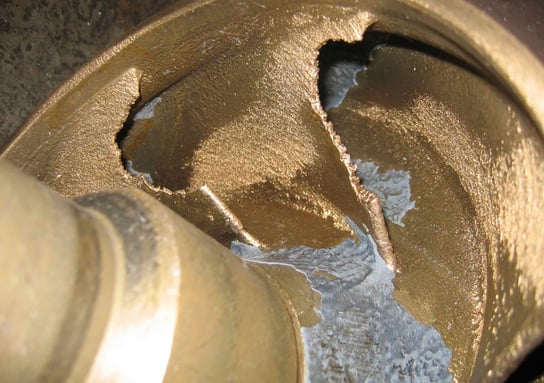 |
| Impeller damage from cavitation. Source: John Anspach Consulting |
Cavitation within a pump can cause pitting in the pump’s impeller, volutes, and casing, which weakens the metal and also hugely increases resistance to flow within the pump. This in turn wrecks pumping efficiency.
When vapor bubbles form within the fluid, they tend to exist only for a short time before collapsing again. When they collapse, they cause intense shockwaves which stress the pump’s internal surfaces. Repeated application of these stresses is what causes the pitting and fractures we see in this image. Cavitation can also introduce shock loads to the shaft and motor, which will decrease their service lives.
2. Fouling
Fouling happens most often in the distribution lines connected to the pump’s intake or outflow, but it is possible for the pump itself to experience fouling as well, when:
- Very fine particulate matter adheres to the pump’s internal surfaces, or
- When a pump ingests coarse particulate matter that it cannot expel out the outflow.
Negative Effects:
- Fouling will greatly decrease a pump’s efficiency and may cause it to fail completely.
 |
| Fouled pumps and irrigation lines. Source: Well Rehabilitation Solutions – BoreSaver |
3. Wear
Groundwater contains particulate matter. And particulate matter can be rough on irrigation pumps:
- Sometimes this is present in very small amounts, and sometimes in very large amounts.
- Regardless of the size of particulates or their concentration, these particulates scour the interior surfaces of a pump and roughen them.
- Just like with pitting, over time this leads to reduction in pumping efficiency because the pump must work harder and harder to move water.
- Eventually the pump can become so worn that it is unable to produce enough lift to supply water to crops.
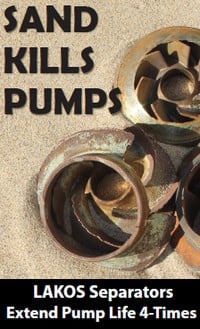 |
| Sand-damaged pump impellers. Source: Lakos Filtration Solutions |
4. Motor issues
- Electric motors can overheat, causing damage to the stator’s insulation.
- If water is introduced into the motor housing this can also damage the insulation and may cause some components to rust.
- These problems can typically be addressed with a rewind and refurbishing process which restores the motor to its original efficiency.
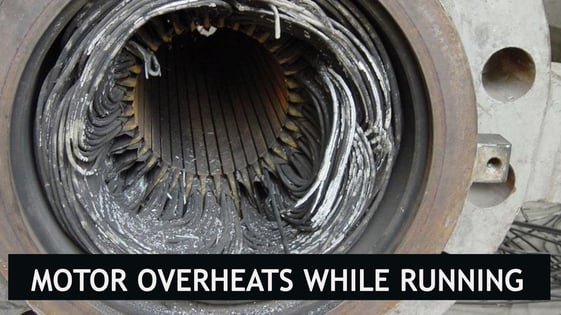 |
| Electric motor stator that has experienced extreme heat damage. Source: https://i.ytimg.com/vi/lEX8HBcLVVM/maxresdefault.jpg |
- Bearing wear may allow the rotor to come into contact with the stator’s surfaces. This is a more serious problem and in extreme cases can result in catastrophic failure of the motor and/or pump.
- Issues related to this typically cannot be repaired, and require motor replacement instead.
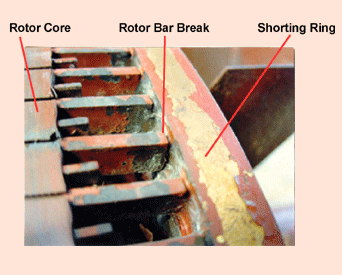 |
|
Damaged electric motor rotor. Source: Maintenance Technology |
5. Water level
As long as the groundwater level is above the intake of the pump, water can be continuously drawn into the irrigation system as seen in this diagram:
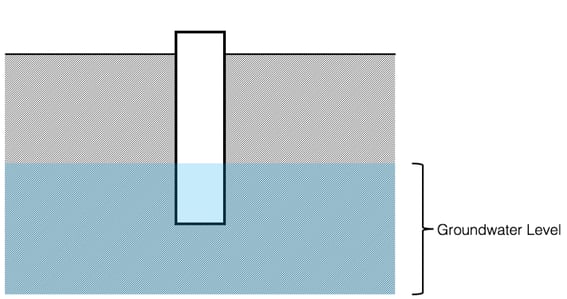
When the pump begins operating, however, there is some amount of dip in the water level locally. This is called drawdown. Sometimes drawdown can bring the water level below the pump intake, resulting in the pump sucking in air. This in turn can cause problems similar to cavitation, as seen in this diagram:
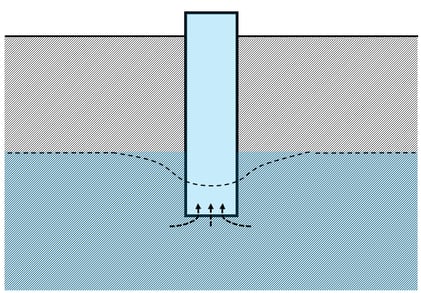
The aquifer can also become depleted. If this happens, the water level throughout the entire aquifer is simply too low for the pump to reach it, and the well must be dug deeper if it is to extract more water.
Aquifer depletion has been an major issue over the last several years during California's unprecedented drought. More growers have had to drill deeper wells to reach ever-lowering water levels in their local aquifer. This in turn causes a need for more energy usage to extract that deeper water, which increases stress on the utility grid and increases growers' utility bills.
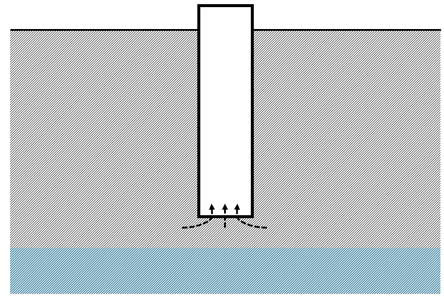
Thanks for hanging with us throughout this educational series. We hope you learned something and can apply it on your farm to drive energy and water savings!
Nathan Taylor, P.E. is a mechanical engineer and an Energy Analyst with Wexus Technologies, Inc.
- For more information about how Wexus' IoT software can drive energy and water efficiency, automation and cost savings for your farming operation, check out our home page here where you can schedule a demo of our software platform or sign up for a free proposal.
- And be sure to follow us for the latest updates and news on Twitter, LinkedIn and YouTube.
